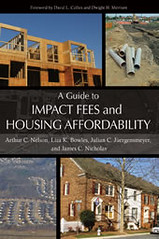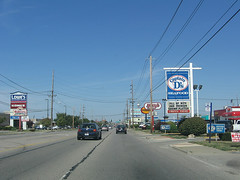Sprawl should pay more for infrastructure, but seldom does

Posted September 26, 2008 at 1:57PM
Arthur C. (Chris) Nelson, whom people like me cite all the time because he knows so much more about real estate and development trends than we do, has a new book out. Titled A Guide to Impact Fees and Housing Affordability, it makes the case that municipal service costs in low-density, sprawling locations can be as much as two and a half times as those in compact, higher-density areas.
 This is because it costs more per unit to build and maintain linear infrastructure such as roads and sewer lines when that the lines have to extend farther per unit. Common sense. Nelson and his co-authors say that total initial municipal costs per person can be as high as $13,426 in sprawl.
This is because it costs more per unit to build and maintain linear infrastructure such as roads and sewer lines when that the lines have to extend farther per unit. Common sense. Nelson and his co-authors say that total initial municipal costs per person can be as high as $13,426 in sprawl.
The same logic also applies to police and emergency services, which must travel longer routes per unit in low-density areas, and it can be extended to private services as well, such as postal and package delivery, and power, telephone, and cable TV lines. On the other side, studies have shown that there is less use and less wear and tear on streets and roads in high-density areas that are near good public transit service.
But the fees imposed on new development by municipalities, if any, seldom make any distinction between compact development and sprawl, or between automobile-dependent locations and transit-oriented ones. This creates a regressive system in which smarter development and, in many cases, less affluent residents, subsidize sprawl by paying more than their fair share while the sprawl residents pay less. Here's one of Nelson's examples of how multi-family housing can subsidize single-family housing:
"During the earlier part of this decade, Volusia County, Fla., charged a flat impact fee of $1,927 per housing unit for fire protection, parks, and public school facilities-regardless of unit type or size. The county perhaps reckoned that with an average of 2.02 persons (based on the 2000 census), the impact of the typical dwelling on these facilities amounts to $954 per person, or $1,927 per unit.
"Census figures, however, show that the average occupancy of single-family detached homes is 2.39 but for apartments it is 1.17, less than half as large. To be proportionate, impact fees should be $2,277 for single-family homes and $1,115 for apartments. Instead, single-family homes pay $350 less than they should while apartments pay $812 more.
"Unfortunately, this is not an isolated situation. Many local governments charge flat impact fees for all residential units based on a single average."
About a dozen years ago, a fellow attorney at NRDC named Mike Fitts and I decided that we wanted to work on sprawl. "Smart growth" hadn't even entered the popular lexicon yet. Mike was already onto the issue of the variable costs of linear infrastructure and service routes, and we came up with the notion that we should build a case for variable fees to reflect more fairly the true cost per unit in various circumstances. A couple of kind private foundations were intrigued enough to fund us to investigate the issue in Chicago and Cleveland.
As a couple of lawyers just starting to think about this set of issues, we were sooooo over our heads, and the grants weren't quite large enough to buy all the expert economic help we would have needed to be rescued from ourselves,  even if we had been smart enough to know that we needed it. But it was a good idea.
even if we had been smart enough to know that we needed it. But it was a good idea.
With the help of fiscal analyst Mike Siegel, we did produce a study showing that not just construction but also operation and maintenance costs cost more in sprawl. Mike also produced a report for us to help citizens decode the arcane minutiae of fiscal impact analysis. (Mike absolutely refused to let me title the guide "Let's Get Fiscal," because he wanted no part of any association with disco music.) And all of what we learned in our thinking and research on sprawl became the foundation of NRDC's book, Once There Were Greenfields. So all was not lost.
Today, Nelson reports encouragingly that some jurisdictions are starting to get it. Atlanta, notably, has reduced impact fees for multifamily housing near transit. (In our own research, we learned that Cleveland has a crude differential pricing system for wastewater infrastructure related to the cost of pumping.) More examples are in the new book.
They need to become the rule rather than the exception, and differentiated fees also need to become the norm not just for one-time impact assessments but also for service bills, such as for water, sewage electricity distribution, that are assessed over time.